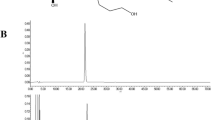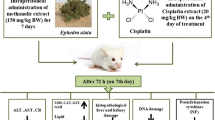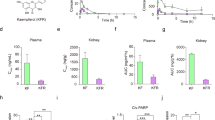Abstract
Cisplatin (CIS) is an effective chemotherapeutic drug used for the treatment of many types of cancers, but its use is associated with adverse effects. Nephrotoxicity is a serious side effect of CIS and limits its therapeutic utility. Haloxylon salicornicum is a desert shrub used traditionally in the treatment of inflammatory disorders, but neither its flavonoid content nor its protective efficacy against CIS nephrotoxicity has been investigated. In this study, seven flavonoids were isolated from H. salicornicum methanolic extract (HSE) and showed in silico binding affinity with NF-κB, Keap1, and SIRT1. The protective effect of HSE against CIS nephrotoxicity was investigated. Rats received HSE (100, 200, and 400 mg/kg) for 14 days followed by a single injection of CIS. The drug increased Kim-1, BUN, and creatinine and caused multiple histopathological changes. CIS-administered rats showed an increase in renal ROS, MDA, NO, TNF-α, IL-1β, and NF-κB p65. HSE prevented tissue injury, and diminished ROS, NF-κB, and inflammatory mediators. HSE enhanced antioxidants and Bcl-2 and downregulated pro-apoptosis markers. These effects were associated with downregulation of Keap1 and microRNA-34a, and upregulation of SIRT1 and Nrf2/HO-1 signaling. In conclusion, H. salicornicum is rich in flavonoids, and its extract prevented oxidative stress, inflammation, and kidney injury, and modulated Nrf2/HO-1 and SIRT1 signaling in CIS-treated rats.
Graphical abstract












Similar content being viewed by others
Data availability
The manuscript and supplementary material contain all data supporting the reported results.
References
Abd El-Twab SM, Hozayen WG, Hussein OE, Mahmoud AM (2016) 18beta-Glycyrrhetinic acid protects against methotrexate-induced kidney injury by up-regulating the Nrf2/ARE/HO-1 pathway and endogenous antioxidants. Ren Fail 38:1516–1527
Abraham NG, Lutton JD, Levere RD (1985) Heme metabolism and erythropoiesis in abnormal iron states: role of delta-aminolevulinic acid synthase and heme oxygenase. Exp Hematol 13:838–843
Ahmad M, Eram S (2011) Hepatoprotective studies on Haloxylon Salicornicum: a plant from Cholistan desert. Pak J Pharm Sci 24:377–382
Ajabnoor M, Al-Yahya M, Tariq M, Jayyab AJF (1984) Antidiabetic activity of Hammada salicornica. Fitoterapia 55:107–109
Al-Asmari AK, Al-Elaiwi AM, Athar MT, Tariq M, Al Eid A, Al-Asmary SM (2014) A review of hepatoprotective plants used in saudi traditional medicine. Evid Based Complement Alternat Med 2014:890842
Aladaileh SH, Al-Swailmi FK, Abukhalil MH, Ahmeda AF, Mahmoud AM (2021) Punicalagin prevents cisplatin-induced nephrotoxicity by attenuating oxidative stress, inflammatory response, and apoptosis in rats. Life Sci 286:120071
Alhoshani AR, Hafez MM, Husain S, Al-Sheikh AM, Alotaibi MR, Al Rejaie SS, Alshammari MA, Almutairi MM, Al-Shabanah OA (2017) Protective effect of rutin supplementation against cisplatin-induced Nephrotoxicity in rats. BMC Nephrol 18:194
Antar SA, Abdo W, Taha RS, Farage AE, El-Moselhy LE, Amer ME, Abdel Monsef AS, Abdel Hamid AM, Kamel EM, Ahmeda AF, Mahmoud AM (2022) Telmisartan attenuates diabetic nephropathy by mitigating oxidative stress and inflammation, and upregulating Nrf2/HO-1 signaling in diabetic rats. Life Sci 291:120260
Auten RL, Davis JM (2009) Oxygen toxicity and reactive oxygen species: the devil is in the details. Pediatr Res 66:121–127
Bancroft JD, Gamble M (2008) Theory and practice of histological techniques. 6th Edition, Churchill Livingstone, Elsevier, China
Bibi N, Tanoli SAK, Farheen S, Afza N, Siddiqi S, Zhang Y, Kazmi SU, Malik AJB, letters mc (2010) In vitro antituberculosis activities of the constituents isolated from Haloxylon salicornicum. Bioorg Med Chem Lett 20:4173–4176
Bonventre JV (2008) Kidney Injury Molecule-1 (KIM-1): a specific and sensitive biomarker of kidney injury. Scandinavian journal of clinical and laboratory investigation. Supplementum 241:78–83
Bosabalidis A, Gabrieli C, Niopas IJP (1998) Flavone aglycones in glandular hairs of Origanum x intercedens. Phytochemistry 49:1549–1553
Boulos L (2005) Flora of Egypt vol. 1, 2, 4. Al Hadara Publishing Cairo, Egypt
Brozovic A, Ambriović-Ristov A, Osmak M (2010) The relationship between cisplatin-induced reactive oxygen species, glutathione, and BCL-2 and resistance to cisplatin. Crit Rev Toxicol 40:347–359
Cheleschi S, De Palma A, Pascarelli NA, Giordano N, Galeazzi M, Tenti S, Fioravanti A (2017) Could oxidative stress regulate the expression of MicroRNA-146a and MicroRNA-34a in human osteoarthritic chondrocyte cultures? Int J Mol Sci 18(12):2660
Chen Q, Ma J, Yang X, Li Q, Lin Z, Gong F (2020) SIRT1 mediates effects of FGF21 to ameliorate cisplatin-induced acute kidney injury. Front Pharmacol 11:241
Chen X, Wei W, Li Y, Huang J, Ci X (2019) Hesperetin relieves cisplatin-induced acute kidney injury by mitigating oxidative stress, inflammation and apoptosis. Chem Biol Interact 308:269–278
Cohen G, Dembiec D, Marcus J (1970) Measurement of catalase activity in tissue extracts. Anal Biochem Anal Biochem 34:30–38
Cvitkovic E (1998) Cumulative toxicities from cisplatin therapy and current cytoprotective measures. Cancer Treat Rev 24:265–281
Do MT, Kim HG, Choi JH, Jeong HG (2014) Metformin induces microRNA-34a to downregulate the Sirt1/Pgc-1α/Nrf2 pathway, leading to increased susceptibility of wild-type p53 cancer cells to oxidative stress and therapeutic agents. Free Radical Biol Med 74:21–34
Ellman GL (1959) Tissue sulfhydryl groups. Arch Biochem Biophys 82:70–77
Elmansy RA, Seleem HS, Mahmoud AR, Hassanein EHM, Ali FEM (2021) Rebamipide potentially mitigates methotrexate-induced nephrotoxicity via inhibition of oxidative stress and inflammation: a molecular and histochemical study. Anat rec (Hoboken, N J : 2007) 304:647–661
Famurewa AC, Ekeleme-Egedigwe CA, Onwe CS, Egedigwe UO, Okoro CO, Egedigwe UJ, Asogwa NT (2020) Ginger juice prevents cisplatin-induced oxidative stress, endocrine imbalance and NO/iNOS/NF-κB signalling via modulating testicular redox-inflammatory mechanism in rats. Andrologia 52:e13786
Ferguson MA, Vaidya VS, Bonventre JV (2008) Biomarkers of nephrotoxic acute kidney injury. Toxicol 245:182–193
Ferheen S, Ahmed E, Afza N, Malik A, Shah MR, Nawaz SA, Choudhary MI (2005) Haloxylines A and B, antifungal and cholinesterase inhibiting piperidine alkaloids from Haloxylon salicornicum. Chem Pharm Bull (Tokyo) 53:570–572
Finlay S, Bray B, Lewington AJ, Hunter-Rowe CT, Banerjee A, Atkinson JM, Jones MC (2013) Identification of risk factors associated with acute kidney injury in patients admitted to acute medical units. Clin Med (London, England) 13:233–238
Gao Y, Liu F, Fang L, Cai R, Zong C, Qi Y (2014) Genkwanin inhibits proinflammatory mediators mainly through the regulation of miR-101/MKP-1/MAPK pathway in LPS-activated macrophages. PLoS one 9:e96741
Ghosh S (2019) Cisplatin: the first metal based anticancer drug. Bioorg Chem 88:102925
Gobec M, Tomašič T, Markovič T, Mlinarič-Raščan I, Dolenc MS, Jakopin ŽJC-BI (2015) Antioxidant and anti-inflammatory properties of 1, 2, 4-oxadiazole analogs of resveratrol. Chem Biol Interact 240:200–207
Gong G, Guan YY, Zhang ZL, Rahman K, Wang SJ, Zhou S, Luan X, Zhang H (2020) Isorhamnetin: a review of pharmacological effects. Biomed pharmacother 128:110301
Grisham MB, Johnson GG, Lancaster JR Jr (1996) Quantitation of nitrate and nitrite in extracellular fluids. Methods Enzymol 268:237–246
Guennewig B, Roos M, Dogar AM, Gebert LF, Zagalak JA, Vongrad V, Metzner KJ, Hall J (2014) Synthetic pre-microRNAs reveal dual-strand activity of miR-34a on TNF-α. RNA (New York, N Y) 20:61–75
Haigis MC, Guarente LP (2006) Mammalian sirtuins—emerging roles in physiology, aging, and calorie restriction. Genes Dev 20:2913–2921
Hassan SM, Khalaf MM, Sadek SA, Abo-Youssef AM (2017) Protective effects of apigenin and myricetin against cisplatin-induced nephrotoxicity in mice. Pharm Biol 55:766–774
Hozayen WG, Mahmoud AM, Desouky EM, El-Nahass ES, Soliman HA, Farghali AA (2019) Cardiac and pulmonary toxicity of mesoporous silica nanoparticles is associated with excessive ROS production and redox imbalance in Wistar rats. Biomed pharmacother 109:2527–2538
Itoh K, Chiba T, Takahashi S, Ishii T, Igarashi K, Katoh Y, Oyake T, Hayashi N, Satoh K, Hatayama I (1997) An Nrf2/small Maf heterodimer mediates the induction of phase II detoxifying enzyme genes through antioxidant response elements. Biochem Biophys Res Commun 236:313–322
Izzedine H, Perazella MA (2017) Anticancer drug-induced acute kidney injury. Kidney Int Rep 2:504–514
Jennes L (2013) Chapter 7—immunohistochemical detection of neuropeptides/transmitters in mammalian brain. In: Conn PM (ed) Methods in Cell Biology. Academic Press, pp 123–147
Juan CA, Pérez de la Lastra JM, Plou FJ, Pérez-Lebeña E (2021) The chemistry of reactive oxygen species (ROS) revisited: outlining their role in biological macromolecules (DNA, lipids and proteins) and induced pathologies. Int J Mol Sci 22(9):4642
Kolli VK, Abraham P, Isaac B, Selvakumar D (2009) Neutrophil infiltration and oxidative stress may play a critical role in methotrexate-induced renal damage. Chemother 55:83–90
Lee KH, Cho J-Y, Lee HJ, Park KY, Ma Y-K, Lee S-H, Cho JA, Kim W-S, Park K-H, Moon J-HJFS, Biotechnology (2011) Isolation and identification of phenolic compounds from an Asian pear (Pyrus pyrifolia Nakai) fruit peel. Food Sci Biotechnol 20:1539–1545
Li W, Li H, Zhang M, Wang M, Zhong Y, Wu H, Yang Y, Morel L, Wei Q (2016) Quercitrin ameliorates the development of systemic lupus erythematosus-like disease in a chronic graft-versus-host murine model. Am J Physiol Renal Physiol 311:F217–F226
Liu M, Grigoryev DN, Crow MT, Haas M, Yamamoto M, Reddy SP, Rabb H (2009) Transcription factor Nrf2 is protective during ischemic and nephrotoxic acute kidney injury in mice. Kidney Int 76:277–285
Livak KJ, Schmittgen TD (2001) Analysis of relative gene expression data using real-time quantitative PCR and the 2(-Delta Delta C(T)) Method. Methods 25(4):402–8
Loverre A, Ditonno P, Crovace A, Gesualdo L, Ranieri E, Pontrelli P, Stallone G, Infante B, Schena A, Di Paolo S, Capobianco C, Ursi M, Palazzo S, Battaglia M, Selvaggi FP, Schena FP, Grandaliano G (2004) Ischemia-reperfusion induces glomerular and tubular activation of proinflammatory and antiapoptotic pathways: differential modulation by rapamycin. J Am Soc Nephrol 15:2675–2686
Lv H, Xiao Q, Zhou J, Feng H, Liu G, Ci X (2018) Licochalcone A upregulates Nrf2 antioxidant pathway and thereby alleviates acetaminophen-induced hepatotoxicity. Front Pharmacol 9:147
Ma X, Tian W, Wu L, Cao X, Ito YJJoCA (2005) Isolation of quercetin-3-OL-rhamnoside from Acer truncatum Bunge by high-speed counter-current chromatography. J Chromatogr A 1070:211–214
Mabry T, Markham KR, Thomas MB (2012) The systematic identification of flavonoids. Berlin: Springer Berlin Heidelberg
Mahmoud AM, Germoush MO, Alotaibi MF, Hussein OE (2017) Possible involvement of Nrf2 and PPARgamma up-regulation in the protective effect of umbelliferone against cyclophosphamide-induced hepatotoxicity. Biomed Pharmacother 86:297–306
Mahmoud AM, Hozayen WG, Ramadan SM (2017) Berberine ameliorates methotrexate-induced liver injury by activating Nrf2/HO-1 pathway and PPARgamma, and suppressing oxidative stress and apoptosis in rats. Biomed Pharmacother 94:280–291
Mahmoud AM, Abd El-Ghafar OAM, Alzoghaibi MA, Hassanein EHM (2021) Agomelatine prevents gentamicin nephrotoxicity by attenuating oxidative stress and TLR-4 signaling, and upregulating PPARγ and SIRT1. Life Sci 278:119600
Mahmoud MA, Sayed MA, Ahmed SO, Abdel-Daim MM, Hassanein HME (2022) The role of flavonoids in inhibiting IL-6 and inflammatory arthritis. Curr Top Med Chem 22:746–768
Marklund S, Marklund G (1974) Involvement of the superoxide anion radical in the autoxidation of pyrogallol and a convenient assay for superoxide dismutase. Eur J Biochem 47:469–474
Markowitz GS, Perazella MA (2005) Drug-induced renal failure: a focus on tubulointerstitial disease. Clinica Chimica Acta 351:31–47
Nagai J, Takano M (2010) Molecular-targeted approaches to reduce renal accumulation of nephrotoxic drugs. Expert Opin Drug Metab Toxicol 6:1125–1138
Nash K, Hafeez A, Hou S (2002) Hospital-acquired renal insufficiency. Am J Kidney Dis 39:930–936
Neamatallah T, El-Shitany NA, Abbas AT, Ali SS, Eid BG (2018) Honey protects against cisplatin-induced hepatic and renal toxicity through inhibition of NF-κB-mediated COX-2 expression and the oxidative stress dependent BAX/Bcl-2/caspase-3 apoptotic pathway. Food Funct 9:3743–3754
Ohkawa H, Ohishi N, Yagi K (1979) Assay for lipid peroxides in animal tissues by thiobarbituric acid reaction. Anal Biochem 95:351–358
Pabla N, Dong Z (2008) Cisplatin nephrotoxicity: mechanisms and renoprotective strategies. Kidney Int 73:994–1007
Pacher P, Beckman JS, Liaudet L (2007) Nitric oxide and peroxynitrite in health and disease. Physiol Rev 87:315–424
Pan H, Wang H, Wang X, Zhu L, Mao L (2012) The absence of Nrf2 enhances NF-kappaB-dependent inflammation following scratch injury in mouse primary cultured astrocytes. Mediat Inflamm 2012:217580
Paueksakon P, Fogo AB (2017) Drug-induced nephropathies. Histopathology 70:94–108
Raynes R, Brunquell J, Westerheide SD (2013) Stress inducibility of SIRT1 and its role in cytoprotection and cancer. Genes Cancer 4:172–182
Redza-Dutordoir M, Averill-Bates DA (2016) Activation of apoptosis signalling pathways by reactive oxygen species. Biochim Biophys Acta (BBA) - Mol Cell Res 1863:2977–2992
Sami DH, Soliman AS, Khowailed AA, Hassanein EHM, Kamel EM, Mahmoud AM (2022) 7-hydroxycoumarin modulates Nrf2/HO-1 and microRNA-34a/SIRT1 signaling and prevents cisplatin-induced oxidative stress, inflammation, and kidney injury in rats. Life Sci 310:121104
Satta S, Mahmoud AM, Wilkinson FL, Yvonne Alexander M, White SJ (2017) The role of Nrf2 in cardiovascular function and disease. Oxid Med Cell Longev 2017:9237263
Sayed AM, Hassanein EHM, Salem SH, Hussein OE, Mahmoud AM (2020) Flavonoids-mediated SIRT1 signaling activation in hepatic disorders. Life Sci 259:118173
Shen C-C, Chang Y-S, Ho L-KJP (1993) Nuclear magnetic resonance studies of 5, 7-dihydroxyflavonoids. Phytochemistry 34:843–845
Shi Y, Chen J, Weng C, Chen R, Zheng Y, Chen Q, Tang H (2003) Identification of the protein-protein contact site and interaction mode of human VDAC1 with Bcl-2 family proteins. Biochem Biophys Res Commun 305:989–996
Siddik ZH (2003) Cisplatin: mode of cytotoxic action and molecular basis of resistance. Oncogene 22:7265–7279
Švajger U, Jeras MJIROI (2012) Anti-inflammatory effects of resveratrol and its potential use in therapy of immune-mediated diseases. Int Rev Immunol 31:202–222
Tan R-Z, Wang C, Deng C, Zhong X, Yan Y, Luo Y, Lan H-Y, He T, Wang L (2020) Quercetin protects against cisplatin-induced acute kidney injury by inhibiting Mincle/Syk/NF-κB signaling maintained macrophage inflammation. Phytother Res 34:139–152
Tanase DM, Gosav EM, Radu S, Costea CF, Ciocoiu M, Carauleanu A, Lacatusu CM, Maranduca MA, Floria M, Rezus C (2019) The predictive role of the biomarker kidney molecule-1 (KIM-1) in acute kidney injury (AKI) cisplatin-induced nephrotoxicity. Int J Mol Sci 20:5238
Vargas F, Romecín P, García-Guillén AI, Wangesteen R, Vargas-Tendero P, Paredes MD, Atucha NM, García-Estañ J (2018) Flavonoids in kidney health and disease. Front Physiol 9:394
Vasaikar N, Mahajan U, Patil KR, Suchal K, Patil CR, Ojha S, Goyal SN (2018) D-pinitol attenuates cisplatin-induced nephrotoxicity in rats: impact on pro-inflammatory cytokines. Chem Biol Interact 290:6–11
Wardyn JD, Ponsford AH, Sanderson CM (2015) Dissecting molecular cross-talk between Nrf2 and NF-κB response pathways. Biochem Soc Trans 43:621–626
Wei Y, Ito YJJolc, technologies r (2007) Isolation of hyperoside and luteolin‐glucoside from agrimonia pilosa Ledeb using stepwise elution by high-speed countercurrent chromatography. J Liq Chromatogr Relat Technol 30:1465–1473
Weston LA, Burke BA, Putnam ARJJoce (1987) Isolation, characterization and activity of phytotoxic compounds from quackgrass [Agropyron repens (L.) Beauv.]. J Chem Ecol 13:403–421
Wilson AJ, Gill EK, Abudalo RA, Edgar KS, Watson CJ, Grieve DJ (2018) Reactive oxygen species signalling in the diabetic heart: Emerging prospect for therapeutic targeting. Heart 104:293–299
Xing JJ, Hou JG, Ma ZN, Wang Z, Ren S, Wang YP, Liu WC, Chen C, Li W (2019) Ginsenoside Rb3 provides protective effects against cisplatin-induced nephrotoxicity via regulation of AMPK-/mTOR-mediated autophagy and inhibition of apoptosis in vitro and in vivo. Cell Prolif 52:e12627
Yang H, Zhang W, Pan H, Feldser HG, Lainez E, Miller C, Leung S, Zhong Z, Zhao H, Sweitzer S, Considine T, Riera T, Suri V, White B, Ellis JL, Vlasuk GP, Loh C (2012) SIRT1 activators suppress inflammatory responses through promotion of p65 deacetylation and inhibition of NF-κB activity. PLoS one 7:e46364
Zahid M, Ishrud O, Pan Y, Asim M, Riaz M, Ahmad VUJCr (2002) Flavonoid glycosides from Salvia moorcroftiana Wall. Carbohydr Res 337:403–407
Zhang J, Fu H, Xu Y, Niu Y, An X (2016) Hyperoside reduces albuminuria in diabetic nephropathy at the early stage through ameliorating renal damage and podocyte injury. J Nat Med 70:740–748
Zhang Y, Tao X, Yin L, Xu L, Xu Y, Qi Y, Han X, Song S, Zhao Y, Lin Y, Liu K, Peng J (2017) Protective effects of dioscin against cisplatin-induced nephrotoxicity via the microRNA-34a/sirtuin 1 signalling pathway. Br J Pharmacol 174:2512–2527
Author information
Authors and Affiliations
Contributions
Conceptualization: A.M.M. Data curation: A.M.M., S.A.R., E.M.K., and E.H.M.H. Formal analysis: A.M.M. Investigation: A.M.M., S.A.R., E.M.K., and E.H.M.H. Methodology: S.A.R., A.M.M.; M.A.E., A.A.K., E.M.K., and E.H.M.H. Project administration: A.M.M. and A.A.K. Resources: A.M.M., M.A.E., and E.M.K. Supervision: A.M.M. Validation: A.M.M. Visualization: A.M.M. Writing—original draft: A.M.M. and E.M.K. Writing—review and editing: A.M.M.
Corresponding author
Ethics declarations
Ethical approval
All animal experiments and procedures were approved by the Institutional Research Ethics Committee of Beni-Suef University (ethical approval no. 020–96).
Consent to participate
Not applicable.
Consent for publication
Not applicable.
Conflict of interest
The authors declare no competing interests.
Additional information
Responsible Editor: Lotfi Aleya
Publisher's note
Springer Nature remains neutral with regard to jurisdictional claims in published maps and institutional affiliations.
Supplementary Information
Below is the link to the electronic supplementary material.
Rights and permissions
Springer Nature or its licensor (e.g. a society or other partner) holds exclusive rights to this article under a publishing agreement with the author(s) or other rightsholder(s); author self-archiving of the accepted manuscript version of this article is solely governed by the terms of such publishing agreement and applicable law.
About this article
Cite this article
Ramadan, S.A., Kamel, E.M., Ewais, M.A. et al. Flavonoids of Haloxylon salicornicum (Rimth) prevent cisplatin-induced acute kidney injury by modulating oxidative stress, inflammation, Nrf2, and SIRT1. Environ Sci Pollut Res 30, 49197–49214 (2023). https://doi.org/10.1007/s11356-023-25694-2
Received:
Accepted:
Published:
Issue Date:
DOI: https://doi.org/10.1007/s11356-023-25694-2




